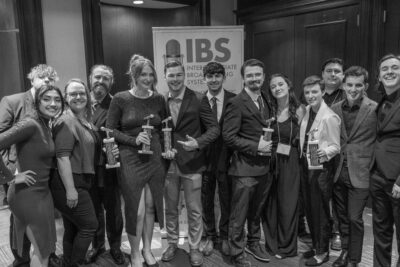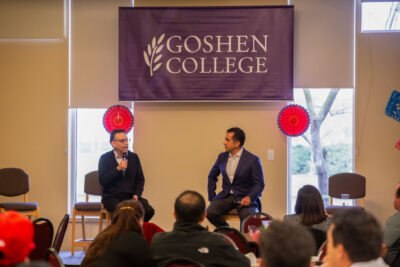Dialogue. This was the main purpose of the “Building an Interreligious Student Community” regional conference in interfaith leadership that Goshen College students, senior Cheyenne Petty, junior Annika Detweiler, sophomores Nasim Rasoulipour, Lydia Dyck and Mandira Panta attended Feb. 2 and 3.
A group of 50, all interested and passionate about interfaith gathered at Saint Mary’s College, South Bend, Ind. for a series of workshops beginning with the foundations of interfaith leadership, storytelling and asset mapping and social action.For Panta, attending this conference was about wanting to hear stories from people of other faiths and their interfaith journeys.
And that’s exactly what the group did.
After setting community agreements for how the group wanted to talk to each other, they were led through a series of activities inviting them engage with one another’s stories around tables.
First, a river activity. Participants drew a river on their paper. They were asked to draw boulders, representing the foundational things in life that have grounded them. Rapids, representing the times that were really difficult in their lives. As well as arrows coming in, representing things that have given them life and then arrows going out, representing the things that have drained them.
The river was to get participants to begin to think about their experiences of feeling listened to in interfaith dialogue.
In groups of five, participants stood up and were given four minutes to share their stories.
“In order to draft our story we looked at three things,” said Detweiler.
“A leadership story is first a story of self, a story of why I have been called.
The story of us, ‘what are the experiences and values we share, as a team, as a campus, as a community?’
Now finally there is a story of now, the fierce urgency of now, ‘how can we implement that now?’”
“It was just crazy to realize that we all have a story to share that we can relate to our community that we can do now,” she said. “That’s a huge part of interfaith, dialogue and story-telling. We need to figure out how to draft our own story in order to dialogue with others.”
This form of storytelling felt different than the testimony sharing Petty was used to in the Christian missionary community she grew up in.
“It always seemed so selfish to talk about yourself,” she said. “The way they made this seem. You start with this is why I’m talking about this, this is how it affects all of us, and this is what we can do about it. There were steps, it wasn’t like this is all about me.”
A spectrum exercise got the group to name how welcoming they feel their campuses are to interfaith dialogue.
Participants were asked to identify if they felt their campus is a welcoming place to different forms of religious diversity, prioritizes interfaith cooperation and if they feel they know where to look for faculty/staff allies.
To end, the conference welcomed a panel of South Bend community members. Among them, a Jew, Muslim, Evangelical Christian, Catholic, Buddhist and Bahá’í.
The panelists talked about their own journeys with interfaith work and what drew them to it. They answered the questions, “What is one aspect of your religion that you want to share with someone?”, “What are other faith practices you’ve taken from other spiritual or faith people?” and
“What is a common misconception about your faith that you wish people would understand?”
“It hit me half-way through the panel’s question and answer period that I was looking at a table where a Jew, Catholic, Muslim, Bahai, Buddhist monk, and Evangelical Christian were sitting, all discussing brilliant plans for Interfaith dialogue and support of each other,” said Dyck. “It kinda blew you away.”
The group from GC hopes to see more coordinated around interfaith cooperation and conversation.
“I think the greatest challenge on this campus will be finding people who are willing to do more than [say] ‘I support you’ and finding allies that are willing to take action and stand with us,” said Petty.
Rasoulipour, a Muslim student at GC, met someone at the conference who is considering converting to Islam. The two are now friends on Facebook.
“The conference definitely showed me that there are more people out there that want to connect with others and are reaching for peace, with many different faiths and backgrounds, than I thought,” said Rasoulipour.

